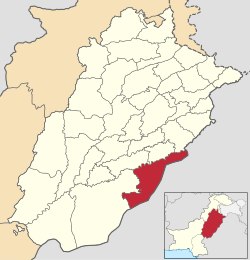Bahawalnagar District
District in Punjab, Pakistan From Wikipedia, the free encyclopedia
Bahawalnagar District (Urdu and Punjabi: ضلع بہاولنگر), is a district of Punjab province in Pakistan. Before the independence of Pakistan, Bahawalnagar was part of Bahawalpur state governed by the Nawab of Bahawalpur. The city of Bahawalnagar is the capital of the district.[3]
Bahawalnagar
ضلع بہاولنگر | |
|---|---|
Top: Marot Fort Bottom: Fields in Chak 38-R | |
 Map of Bahawalnagar District (highlighted in red) within Punjab. | |
| Country | Pakistan |
| Province | Punjab |
| Division | Bahawalpur |
| Headquarters | Bahawalnagar |
| Government | |
| • Type | District Administration |
| • Deputy Commissioner | Muhammad Waseem |
| • District Police Officer | Muhammad Essa Khan Sukhera |
| Area | |
| 8,878 km2 (3,428 sq mi) | |
| Population | |
| 3,550,342 | |
| • Density | 400/km2 (1,000/sq mi) |
| • Urban | 974,118 |
| • Rural | 2,576,224 |
| Literacy | |
| • Literacy rate |
|
| Time zone | UTC+5 (PKT) |
| Area code | 063 |
| No. of Tehsils | 5 |
| Tehsils | Bahawalnagar Chishtian Fort Abbas Haroonabad Minchinabad |
| Website | bahawalnagar |
District boundaries
The boundaries of Bahawalnagar in the east and south touches the Indian territory of Bikaner and Firozpur districts[4] while Bahawalpur district lies on its west and river Sutlej flows on its northern side. District Bahawalnagar spreads over an area of 8878 square kilometers.[5]
History
Nawab Bahawal Khan-1[6] as second nawab of Bahawalpur ascended the throne in 1746 A.D.
Muhammad Mubarik, after ruling successfully for years, died issueless in 1772 A.D. He was succeeded by his nephew Sahibzada Jafar Khan alias Nawab Muhammad Bahawal Khan-II[7] in 1772.
Administration

The district of Bahawalnagar is spread over an area of 8,878 square kilometres (3427.8 square miles) comprising five tehsils and 118 Union Councils:[8]
| Tehsil[9] | Area
(km²)[10] |
Pop.
(2023) |
Density
(ppl/km²) (2023) |
Literacy rate
(2023)[11] |
Union Councils |
|---|---|---|---|---|---|
| Bahawalnagar[8] | 1,729 | 976,049 | 564.52 | 53.5% | 31 |
| Chishtian[8] | 1,500 | 845,439 | 563.63 | 60.49% | 29 |
| Fort Abbas[8] | 2,536 | 510,253 | 201.20 | 61.36% | 16 |
| Haroonabad[8] | 1,295 | 615,476 | 475.27 | 66.28% | 22 |
| Minchinabad[8] | 1,818 | 603,125 | 331.75 | 44.05% | 20 |
| Total | 2,981,919 | 118 |
Demographics
Summarize
Perspective
| Year | Pop. | ±% p.a. |
|---|---|---|
| 1951 | 630,430 | — |
| 1961 | 822,827 | +2.70% |
| 1972 | 1,073,891 | +2.45% |
| 1981 | 1,373,747 | +2.77% |
| 1998 | 2,061,447 | +2.42% |
| 2017 | 2,975,656 | +1.95% |
| 2023 | 3,550,342 | +2.99% |
| Sources:[12] | ||
As of the 2023 census, Bahawalnagar district has 557,616 households and a population of 3,550,342.[13] The district has a sex ratio of 108.27 males to 100 females and a literacy rate of 57.01%: 63.55% for males and 49.95% for females.[1][2] 971,921 (27.42% of the surveyed population) are under 10 years of age.[14] 974,118 (27.44%) live in urban areas.[1]
Religion
| Religion in Bahawalnagar district (2023)[15] | ||||
|---|---|---|---|---|
| Religion | Percent | |||
| Islam | 99.45% | |||
| Christianity | 0.41% | |||
| Other or not stated | 0.14% | |||
In 2023, 19,653 (0.55%) were from religious minorities, of which Christians were 14,577, Hindus (incl. Scheduled Castes) 3,106, Ahmadi 1,598, Sikhs 39, Parsis 2, and 331 others.[15]
Languages
At the time of the 2023 census, 94.08% of the population spoke Punjabi, 3.35% Urdu and 1.74% Saraiki as their first language.[17]
Shrine of Tajuddin Chishti
Shaikh Khawaja Tajuddin Chishti also known as Taj Sarwar Chishti was a Sufi saint of Chishti Order. He was a grandson Shaikh Farid-ud-din Ganjshakar of Pakpattan and his descendants founded the village of Chishtian around 1265 CE (574 Hijri, Islamic calendar). Many native tribes in Punjab region accepted Islam due to his missionary Dawaah. Shaikh Khawaja Tajuddin Chishti faced hostility from many Mughal and Turk tribes that opposed his Muslim missionary Daawah as it interfered with their plans and he was martyred in a battle and was buried in Chishtian. Shrine of Sufi saint Shaikh Khawaja Tajuddin Chishti, located at the city of Chishtian. The dargah of Shaikh Taj-ud-din Chishti is called Roza Taj Sarwar.[18]
See also
References
Wikiwand - on
Seamless Wikipedia browsing. On steroids.


